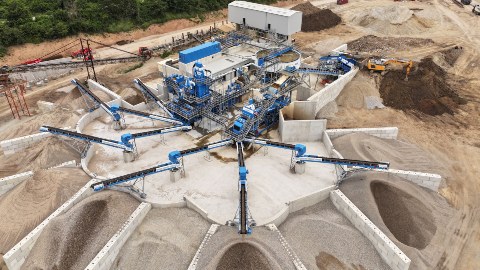Harford Minerals, which operates one of Maryland’s premier reclamation facilities, has reinforced its commitment to sustainability and a full lifecycle approach to materials usage following a multi-million dollar investment in a new state-of-the-art wet processing plant for construction, demolition and excavation (CD&E) waste.
When commissioned later this year, the new plant will be utilized to accept CD&E waste from various sources and produce a range of recycled sand and aggregate products that can be reintroduced to the local construction industry as sustainable alternatives to virgin quarried materials.
Among the materials the plant will produce are washed coarse and fine sands as well as various sized, multipurpose aggregates. As the plant can be adjusted, the final product output can be fine tuned to meet the market’s needs and customers' own specifications.
Harford’s CD&E solutions will also enable the Maryland-based company to partner with public and private entities to process material from local construction and infrastructure projects. Overtime, these recycling efforts will help establish a full-cycle materials economy, thereby moving the industry and region towards a more sustainable future.
Founded in 1965, Harford became renowned for its premium silica sands, which it supplied to the golf industry.
In more recent years, the company diversified and established one of the region’s leading reclamation facilities, where in 2014, it began producing recycled aggregates and, two years later in 2016, introduced crushing operations to recover saleable materials from incoming inert waste.
Its 80-acre campus is dedicated to supporting the circular economy by providing a one-stop facility for local construction companies to responsibly dispose of CD&E waste and back-load their fleet with valuable recycled materials that can be reintroduced to the construction industry for use in high-value applications.
“We first encountered CDE at ConExpo last year and were extremely impressed with its technology and the potential to apply it back home to local CD&E waste.”
“We’re passionate about sustainability and minimizing our environmental footprint. With a partner like CDE, we can better embody our core values and pioneer new technologies in our region. It’s this type of technology and investment that will stimulate progression in our industry, steering it towards a more sustainable future.”
Consultations for CDE’s latest recycling project with Harford were facilitated virtually, explains its business development director for North America, Darren Eastwood.
“What makes this project unique is how it has progressed despite the challenges caused by the pandemic. Very soon after ConExpo concluded strict restrictions came into effect, so our negotiations and consultations over the past year with Harford have been conducted remotely. This is a huge endorsement for CDE as it demonstrates great confidence in our solutions for helping Harford to achieve its commercial and environmental aims.”
According to the U.S. Environmental Protection Agency (EPA), 600 million tons of C&D debris was generated in 2018 with concrete representing the largest fraction (67.5%). The second largest end destination for C&D debris after aggregate (52%) was landfill (24%)1. This means that a quarter of all C&D debris, that could otherwise be repurposed, is simply discarded.
Investment in sustainable solutions is important for the future viability of materials processing companies, explains Eastwood.
“The industry needs to fundamentally transform its practices. Every day we see significant volumes of CD&E waste being sent to landfill, but with the right technology and the willingness to adapt to new ways of working this material can be recycled to recover high valuable construction sand and aggregates and returned to good use in the industry. What a business does now could define its future, either creating opportunity for sustainable growth or restricting its potential due to not addressing its environmental impacts.”
Its investment in our recycling solution represents the largest single investment in Harford’s history.
Eastwood adds: “We’re very pleased to partner with Harford to deliver our latest recycling project in North America. Harford’s management team not only recognizes the urgency of the issues affecting the industry but responds to it with the ambition to act and invest in new technology to drive positive and transformational change.”





